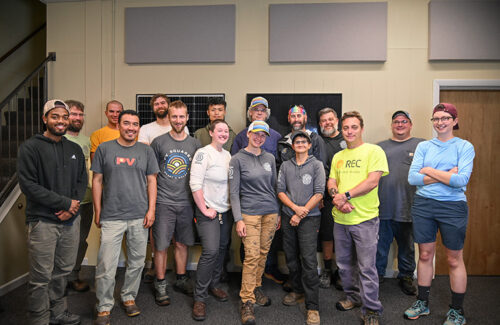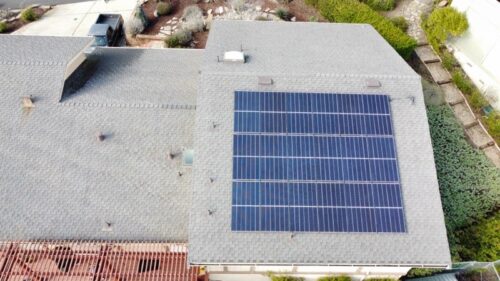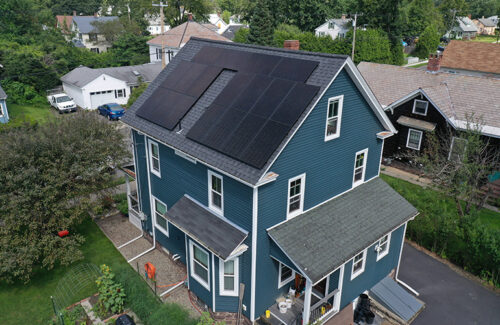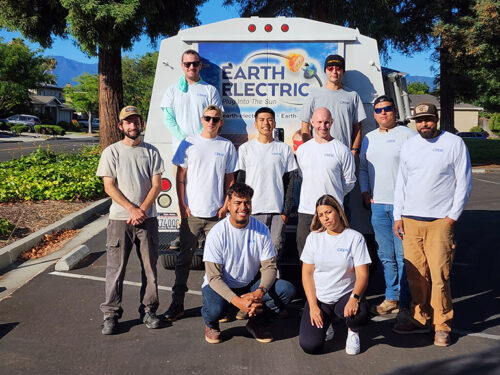| Solar Power World | August 21, 2023
The steps to building a solar array are mostly the same anywhere an installer is putting panels on a roof. They secure mounts and racking, attach modules and inverters and run wiring. It’s physically demanding work, but with the right experience, a solar installer could move anywhere in the country, pick up some panels and get them on a roof and quickly generating power.

The installation crew at PV Squared, an employee-owned solar contractor from Massachusetts. PV Squared
The installation crew at PV Squared, an employee-owned solar contractor from Massachusetts. PV Squared
The mechanical experience of installing arrays in various regions may differ only slightly based on their separate environments with distinct temperatures and weather conditions. The greater difference is in oversight from regional policies and permitting bodies.
Solar Power World case studies typically profile a single solar project and the unique challenges the contractor faced while building it. This case study will instead highlight solar arrays built by two contractors in California and Massachusetts and the many shared and separate experiences those companies encounter daily at a regulatory level.
Earth Electric is a solar installation company founded in California in 2009 that serves the greater San Jose area. PV Squared is a worker-owned solar contractor from Greenfield, Massachusetts, that has been in business since 2002.
This is what it’s like installing solar on opposite sides of the country.
Rate structure and interconnection in the biggest solar state
Earth Electric completed a 7.38-kW residential solar + storage project in Morgan Hill, California, a rural community southeast of San Jose. The array uses an Enphase Encharge 10, a 10-kWh lithium-iron phosphate (LFP) battery that integrates with the manufacturer’s IQ8A microinverters; rail-based racking with metal sheet flashing and mounts from IronRidge; and 410-W solar modules from Panasonic.
This project in Morgan Hill is one of the last to be included in the previous net-metering rates in the state, and it’s a model for what an ideal solar array will look like in California moving forward.
Earth Electric installed a 7.38-kW solar + storage project atop a home in Morgan Hill, California.

Earth Electric installed a 7.38-kW solar + storage project atop a home in Morgan Hill, California.
California remains the top-ranking state for total installed solar capacity in the United States, with part of that success owed to its net-metering compensation rates. But in April 2023, the state adopted new net-billing rates, called NEM 3.0, that have reduced export compensation based on utility time-of-use rates.
“It’s a big education process. The sales cycle is going to be longer and certainly there’s a lot less incentive to sign up to do solar. They need to add storage in order to get better coverage of their electricity bill, which is obviously a much higher contract cost. It’s radical and it’s concerning,” said Sheryl Lane, CEO and founder of Earth Electric.
Solar installers like Earth Electric are prioritizing energy storage sales on projects to counteract the solar compensation reduction. Lane said the company is changing how it’s modeling solar projects, sizing them to cover just under 100% of electrical usage, “because they’re never going to get a ‘zero’ bill anymore.”
Solar + storage is also a necessity in Earth Electric’s installation territory because of wildfire risk and rolling blackouts from regional utility PG&E.
Along with the longer payback period, Earth Electric has also struggled with project delays due to PG&E’s interconnection delays.
“PG&E is extremely unorganized,” Lane said. “We can figure out and overcome the building department and electrical components and all that, but PG&E is probably our biggest speed bump.”
In one instance, the utility required a transformer upgrade for a residential solar project built in March 2022. It took a year and three months before PG&E finally completed that process.
“They paid for and had their system installed and it sat there for over a year,” Lane said. “This is in the middle of a major city in California.”
The New England ratios
PV Squared installed a 6.57-kW solar project on a 1930s home with a steep pitched roof in Greenfield, Massachusetts, in June. The array is composed of Hanwha Qcells Q.PEAK DUO modules, SolarEdge HD Wave 6-kW string inverters and IronRidge HUG Halo UltraGrip top-attached mounts.
On this project, and most others in Massachusetts, PV Squared had to maintain an install crew that had a one-to-one ratio for licensed electricians to electrical apprentices during construction. The state mandates that solar projects must be built by licensed electricians with an apprentice to match, so PV Squared deploys crews with an even number of installers.
PV Squared installed a 6.57-kW solar project atop a home in Greenfield, Massachusetts. PV Squared

PV Squared installed a 6.57-kW solar project atop a home in Greenfield, Massachusetts. PV Squared
“For us, it’s much more expensive to install in the state, because licenses are hard to come by,” said Chris Dooley, team manager at PV Squared. “It does make it harder for us to participate in other states, because we just have to be able to cover our overhead and electricians are making $55 an hour.”
PV Squared runs an in-house apprenticeship program and pays for electrical schooling for those apprentices to become licensed electricians. Altogether, it’s a four-year process to complete, and PV Squared requires people who become licensed through the program to stay at the company for at least a year.
“We have a list of approved non-ratio work, but it depends on where you’re working,” Dooley said. “You’re always going to be better off running in the ratio, because you can get in a lot of trouble and get your license taken with the state if you’re not.”
Currently, PV Squared has more licensed electricians on staff than apprentices but must maintain an even ratio of electrician-to-apprentice on most projects. The company is trying to build a more diverse workforce by including people who identify as female and nonbinary on staff. But it hasn’t been simple hiring this way, because about 96% of current electricians in the United States are men. Even with that 96%, rooftop work may not be attractive to an aging population of skilled laborers.
“Solar installation, especially on a pitched roof, is physically challenging, and it’s hard on the knees and the joints,” said Josh Hilsdon, design and sales consultant for PV Squared. “Not that many 55-year-old electricians are excited about doing rooftop work. It just becomes a puzzle of: How do you get a licensed electrician to come work for you in a very competitive labor environment?”
Universal solar struggles
Massachusetts has its electrician ratio requirement, while California has a changing net-metering policy and utilities slow to interconnect. But both states experience a gamut of permitting and inspection roadblocks that often increase solar project lead times.
The solar project Earth Electric installed in Morgan Hill, California, took about a month to complete, including reviews from the local building department and permitting approvals. In its experience with permitting and utility interconnection, that timeline is on the shorter end for Earth Electric.
The crew at Earth Electric, a solar contractor installing in the greater San Jose area. Earth Electric

The crew at Earth Electric, a solar contractor installing in the greater San Jose area. Earth Electric
“Once we started incorporating batteries and storage into the projects, that’s when we started running into the biggest challenges with trying to meet all of the various code requirements that we’ve got out here,” said Zach Shepard, general manager at Earth Electric. “Trying to make the fire departments happy, trying to make the building departments happy, trying to make it work with the equipment that we’re dealing with, too.”
Authorities having jurisdiction (AHJs) each have their own set of permitting criteria for approving solar projects. In some AHJs, both the solar and storage aspects of a single project would undergo fire and building inspections and require separate building permits.
PV Squared’s installation territory is between five counties in Western Massachusetts, and the contractor has installed in 50 different cities. Each of those cities has an inspector and building department with its own quirks and project requirements.
The company recently failed an inspection after installers placed a plaque showing the project layout on the north side of a building instead of how a firefighter would view it when entering the property, which is something the contractor hadn’t had issues with previously. Meanwhile, Earth Electric recently failed a few inspections for not including enough safety warning stickers.
“These kinds of little things get you returning to site, and you might have done 50 projects with the exact same thing, but either an inspector changes their mind or you’re working in the next town over and it’s just a different story,” said PV Squared’s Hilsdon.
Fire setbacks are another hurdle for both contractors, with no uniform approach to inspecting them among AHJs. Setback requirements already existed in California and were just this year adopted in Massachusetts. Solar installers are required to place solar modules a designated distance from the edge of the roof and other roof obstructions.
Both Earth Electric and PV Squared will leave an 18-in. gap from the top of the array to the roof ridge and a 36-in. walkway to navigate the roof. Fire setbacks are meant to prevent solar arrays from obstructing firefighters while on the job, but they can reduce project sizes.
“It seems like every year drops some new, painful wrinkle into the workflow, and this year fire setbacks are our current, new thing,” Hilsdon said. “We really are seeing everything from fire officials in one town saying, ‘I’m not interested in enforcing any setbacks and you all can continue business as usual,’ to other towns saying, ‘We’re going to enforce this and the most conservative interpretation and not allow any reasonable exemptions.’”
Solar contractors are installing PV arrays from coast to coast. In every community within that span, they’re adapting to whatever regulatory hurdles they encounter to make these projects work. A solar project isn’t just a series of components working in conjunction to turn sunlight into electricity, it’s the culmination of construction expertise and regulatory knowhow that makes the grid greener a few kilowatts at a time.

